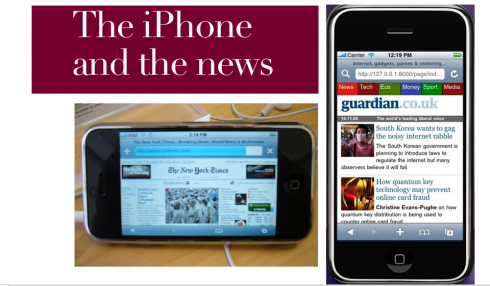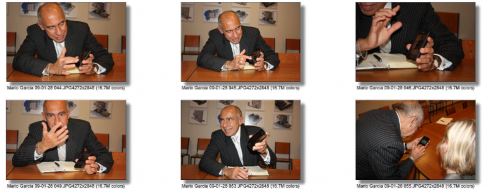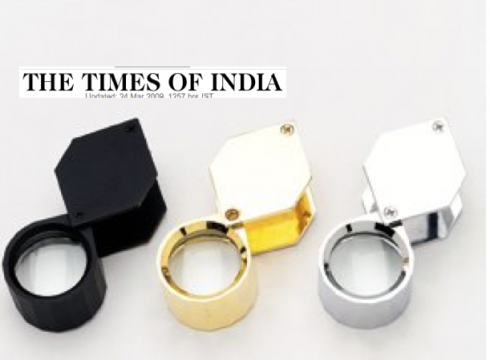Updated Tuesday, March 24, 04:05 EST

The New York Times and The Guardian already make their content available on the iPhone

My iPhone and Me, sort of inseparable, as shown on this photo taken in Stockholm by Gunnar Fahlstrom, in which the iPhone became protagonist.
Yes, I confess I love my iPhone, and I don’t mind that I stood in line for 45 minutes a hot June Florida afternoon to get it on the day it was released in 2007. My iPhone and I are inseparable. Recently, when I sent my daughter Elena a photo taken during one of my work sessions, I just wanted her to see the surroundings, but all she saw was the iPhone by my side:
“Dad,” she inquired, “can’t you stay away from that iPhone even for a second for a photo?”
“No,” I said, “the reason I had it by my side is that I was showing pictures of your baby to the others in the room.”
That seemed to have calm her. But, she is right. With my iPhone, I am constantly connected, read my emails, read newspapers online, get breaking news alerts, check the weather forecast for the next city I am flying to, calculate number of miles run during a specific week, photograph things of interest, make notes on the yellow stickies. It is my office. My umbilical cord to all of my support systems, including my kids, grandkids, and close friends. I enjoy USA Today thru my iPhone, and I get all the alerts The New York Times and The Wall Street Journal send on important stories.
On Sundays, when I am in a remote part of the world, I read the Sunday New York Times right on my iPhone.
So , it is with great satisfaction that I read about what the iPhone is about to offer all of us.
A review of the offerings, from the Poynter Institute website, www.poynter.org, outlines what’s new and of potential interest to news people. I offer the highlights of an article titled iPhone 3.0 Software Offers New Applications for News by Amy Gahran and Barb Iverson:
Since we are already getting “news” from our mobile telephones (in fact, the number of people getting news via cellphone doubled from 10.8 million in January, 2008 to 22.4 million in January, 2009, according to comScore), then it should not surprise anyone that we are definitely at the doorstep of what could become a monumentally important historical shift in the way we receive information—-one that can definitely, and positively, affect newspapers and how they transform their business—-and even make some money in the process.
But back to the article:
Apple announced last week that the iPhone OS 3.0 software (to be distributed summer 2009) will allow users and developers to do many new things, several of which will have a direct positive impact on our ability to use the iPhone to get news.
Two important new features of the iPhone
1. Copy and paste. Yes, we all have missed the ability to do this very simple (and old) step. But now we will be able to read an article, copy it, paste it and send it, amplifying the scope of that information by far.
2. The Application Store: This is the business side that may interest publishers.I, for one, can see me subscribing to receive certain sections of newspapers that I like, and just to get them on my iPhone would be a treat worth a fee.iPhone apps can be sold outright to users for a direct revenue stream. However, even free iPhone apps can help build online businesses (including for news publishers, advertisers, or news-related services) by growing audience, increasing user engagement, or enabling additional features or services.
One importnat point: The latest iPhone software developer kit offers over 1,000 new iPhone application programming interfaces (APIs). Many news organizations, including The New York Times and USA Today, as well as The Guardian of London, already offer their own iPhone applications. But the new APIs just announced by Apple will allow whole new types of interaction with the iPhone and with iPhone applications.
To me, this is where the iPhone/News connectivity offers great potential. A win win situation for everyone, as we would be able to purchase content or services from the application using the Store Kit framework.
This is only the beginning of how my favorite toy, the iPhone, will become even more valuable. Will this save the troubled newspaper industry? Time will tell. But, for now, storytellers rejoice, and business managers pay attention, you could start getting some cash for your goods right thru the iPhone cash registers——which will be available, by the way.
To read the entire Poynter.org piece on iPhone:
http://www.poynter.org/column.asp?id=31&aid=160277
Newspaper interaction with the iPhone
At The New York Times, the NYTimes iPhone application allows users get TheTimes on your iPhone, wherever you are. Specifically designed to utilize the features and navigation of the iPhone, this application downloads and syncs the latest news directly to your device and it is compatible with the iPhone, iPhone 3G and iPod Touch with operating systems version 2.x. One of my favorite features: you can customize options and select your favorite sections of The Times for one-touch access
The iPhone inspires a thesis
It had to happen. It was only a matter of time. I am delighted to announce that a graduate journalism student at Ball State University, in Muncie, Indiana, is devoting her thesis research to the iPhone.
Meet Megan McNames, a graduate assistant at Ball State, who is trying to determine iPhone users’ attitudes toward using the device.
All the dots connect, and I come in touch with Megan because my friend and colleague Dr. Pegie Stark Adam is a guest lecturer at Ball State this week. She met Megan and immediately was emailing me about Megan’s project, and how it can help journalists.
Megan says that people constantly ask her why she is doing a thesis on the iPhone.
I tell people about it and they ask, “but you’re in journalism?” as if they can’t figure out what the iPhone has to do with journalism. It has everything to do with journalism, and m-commerce, and the Internet, and how we communicate with each other and so on because in the future, it will be the platform we conduct all of these professions on. I figure I am just trying to help journalists not miss the boat on this one.
She has a point. As a former reporter, I can only imagine what a magnificent tool the iPhone is to keep in your pocket while doing a story, researching it and filing it on the spot.
Back to Megan’s thesis: specifically, she wants to know if users of the iPhone do find it easy to use, useful, self-expressive, enjoyable to use and/or worth the money? If so, which of these motivations is more important in their decision to keep using the device? She is using a survey to answer these questions. In addition, Megan is also conducting usability studies with both iPhone owners and non-owners. They either bring in their iPhone or I give them one for about an hour and ask them to complete several tasks on the device. She will then compare their use to see if the users were faster, made fewer mistakes, etc.
I think it’s important for journalists like myself to understand how and why these devices are being used. We spend so much time trying to stem the losses our print products are sustaining that we often miss the boat on new technology. (Where were we on the iPod, for example. How come when I unplug my iPod from the computer in the morning I have new podcasts but I can’t read an e-edition of my local newspaper? Who wouldn’t love that?) We really need to spend some time understanding why people use the technology that is straining our business model and how we can satisfy their needs through that technology. I also hope my research will be helpful to the developers of mobile functionality.
And, Megan, it would help our fellow journalists to know how reporters use the iPhone for specific assignments. Start with your own fellow students on campus. The iPhone is the new Reporters Notebook, with far reaching applications and the ability to allow reporters to tell better and more accurate stories. As I always say here, there is no better time for storytellers, and the iPhone may be one of the reasons.
Anyone interested in this project, or with suggestions, can contact Megan directly at
megan.mcnames@gmail.com
The world’s smallest text type?

Perhaps the Times of India should provide all subscribers with colorful loupes like these to facilitate reading
Report from India #2: I have put off asking this question long enough, like for the 12 years I have been visiting this beautiful country of India.
Is it possible that the venerable Times of India sports the smallest text type of any newspaper in the world? I struggle with story after story, and sometimes give up, as it is virtually impossible to read for more than 5 minutes without developing eye fatigue.
I think the text type is set in about 8 points. But the horoscope must be set in about 5 points. Yes, in this case, knowing what your future holds can wait. Better to preserve your eyesight for today.
One of my acquaintances here tells me: Well, Indian newspapers like to pack all the can in there. That is why the type is so small, perhaps.
MY second question is: does the Times of India have any readers over 50 years of age? Are they complaining?
Update on Times of India: One of my sources here made a call to the Times of India art department and found out that type is set 7.5 points, with half point of leading across the board. The horoscope, which is set in 6 points.
Should the marketing department provide colorful loupes to go along with a subscription? Just wondering.
The Monocle Weekly: Mario in the Tyler Brulé radio show

Sunday’s The Monocle Weekly radio show was devoted to the future of news; Tyler Brulé‘s guests discuss the end of the Seattle P-I, the future of network news
On the heels of the Seattle Post-Intelligencer’s final printed edition, Tyler Brulé devotes his weekly Monocle Radio show to the future of newspapers. I was honored to be one of the guests.
For those interested to listen: the program aired live Sunday, March 22, at 12:00 CET and is downloadable on iTunes as The Monocle Weekly and is available to listen to on Monocle’s website, www.monocle.com.
From www.monocle.com:
This week Tyler Brûlé anchors the show from New York and takes a special look at the current state of the media industry. Newspaper design guru and consultant Mario García shares his insights about where print media is heading and Kate O’Brian, senior vice president for news at ABC, is in the studio to talk about the future of the network nightly newscast. In the face of financial cutbacks across the board we also take a look at how the US market is treating the design community, with Jenna Lyons, creative director of J.Crew, and architect Deborah Berke. Monocle’s bureau chief for the Americas Ann Marie Gardner is also in the studio and editor Andrew Tuck joins the team on the line from London. We also hear from culture editor Robert Bound, who’s visiting Sharjah for the Art Biennial.
Mario Garcia Jr. discusses online navigation

Go here:Is top navigation still necessary on news sites?
http://garciainteractive.com/blog/view/37/
:
To read TheRodrigoFino blog, in Spanish, go:
https://garciamedia.com/latinamerica/blog/
TheMarioBlog posting #222